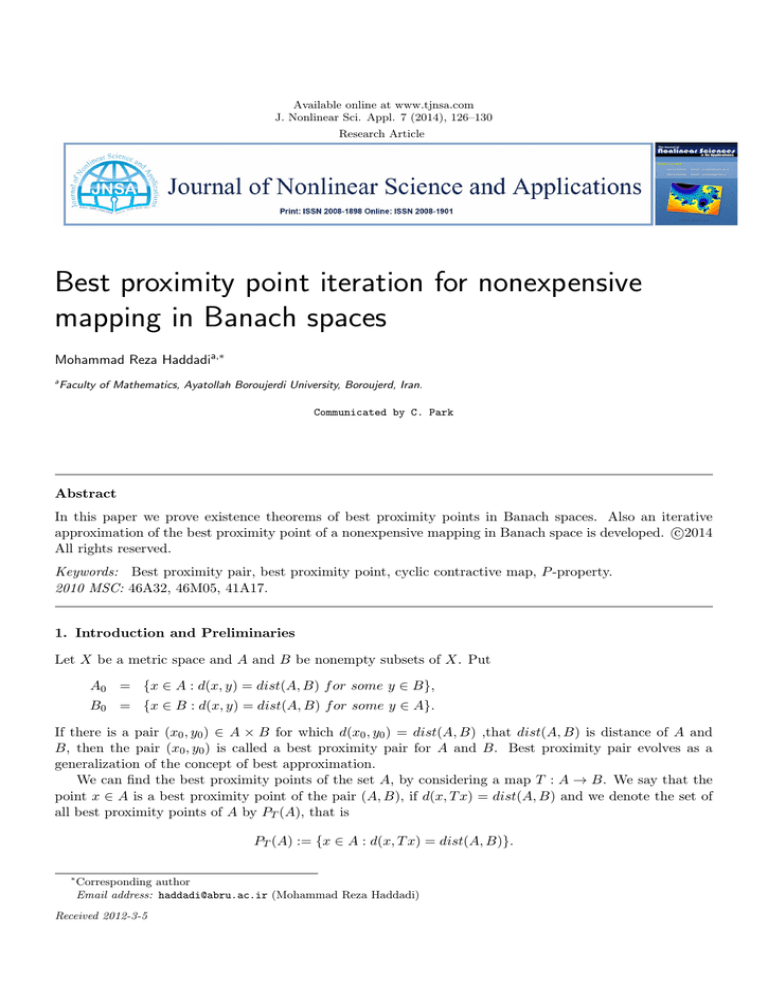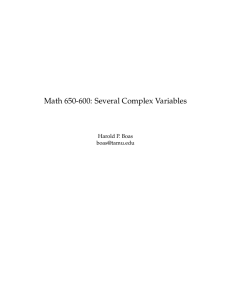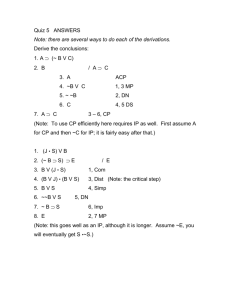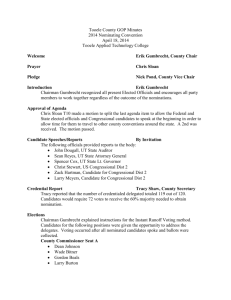
Available online at www.tjnsa.com
J. Nonlinear Sci. Appl. 7 (2014), 126–130
Research Article
Best proximity point iteration for nonexpensive
mapping in Banach spaces
Mohammad Reza Haddadia,∗
a
Faculty of Mathematics, Ayatollah Boroujerdi University, Boroujerd, Iran.
Communicated by C. Park
Abstract
In this paper we prove existence theorems of best proximity points in Banach spaces. Also an iterative
c
approximation of the best proximity point of a nonexpensive mapping in Banach space is developed. 2014
All rights reserved.
Keywords: Best proximity pair, best proximity point, cyclic contractive map, P -property.
2010 MSC: 46A32, 46M05, 41A17.
1. Introduction and Preliminaries
Let X be a metric space and A and B be nonempty subsets of X. Put
A0 = {x ∈ A : d(x, y) = dist(A, B) f or some y ∈ B},
B0 = {x ∈ B : d(x, y) = dist(A, B) f or some y ∈ A}.
If there is a pair (x0 , y0 ) ∈ A × B for which d(x0 , y0 ) = dist(A, B) ,that dist(A, B) is distance of A and
B, then the pair (x0 , y0 ) is called a best proximity pair for A and B. Best proximity pair evolves as a
generalization of the concept of best approximation.
We can find the best proximity points of the set A, by considering a map T : A → B. We say that the
point x ∈ A is a best proximity point of the pair (A, B), if d(x, T x) = dist(A, B) and we denote the set of
all best proximity points of A by PT (A), that is
PT (A) := {x ∈ A : d(x, T x) = dist(A, B)}.
∗
Corresponding author
Email address: haddadi@abru.ac.ir (Mohammad Reza Haddadi)
Received 2012-3-5
M. R. Haddadi, J. Nonlinear Sci. Appl. 7 (2014), 126–130
127
A huge number of generalizations of this principle appear in the literature. Fixed point theory is one
of the most fruitful and effctive tools in mathematics which has many applications with in as well as out
side mathematics [1], [8]. The best proximity point theorem for contractive mappings has been detailed
in Sadiq Basha [9]. Anthony Eldred et al. [3] have elicited a best proximity point theorem for relatively
nonexpansive mappings, an alternative treatment to which has been focused in Sankar Raj and Veeramani
[11]. A best proximity point theorem for contraction has been obtained in Sadiq Basha [10]. Raj V. Sankar in
[12] have discussed best proximity point theorems for contractive non-self-mappings and Abkar and Gabeleh
continued it in [2], [5]. Best proximity point theorems for various variants of contractions have been explored
Eldred and Veeramani [4], Haddadi and Moshtaghioun [6]. P -property introduced for studied the existence
of best proximity point for weakly contractive mapping, for instance [2],[5],[12]. In the following we give
some definitions and preliminaries that is need for main results.
Definition 1.1. ([12]) Let A and B be nonempty subsets of a metric space X with A0 6= ∅. The pair (A, B)
is said to have P -property if
d(x1 , y1 ) = dist(A, B)
⇒ d(x1 , x2 ) = d(y1 , y2 ).
d(x2 , y2 ) = dist(A, B)
Definition 1.2. ([4]) Let X be a complete metric space and A and B subsets of X. A map T : A∪B → A∪B
is a cyclic contraction map if it satisfies:
(i) T (A) ⊂ B, T (B) ⊂ A
(ii) d(T x, T y) ≤ kd(x, y) + (1 − k)dist(A, B) for all x ∈ A and y ∈ B.
Lemma 1.3. ([13]) Let {an } ⊂ [0, ∞), {bn } ⊂ [0, ∞) and {cn } ⊂ [0, 1) be sequences of real numbers such
that
an+1 ≤ (1 − cn )an + bn ∀n ∈ N,
∞
X
n=1
cn = ∞,
∞
X
bn < ∞.
n=1
Then, limn→∞ an = 0.
Definition 1.4. ([12]). Let (A, B) be a pair of two nonempty subsets of a complete metric space X. A
map T : A → B is said to be a weakly contractive mapping if
d(T x, T y) ≤ d(x, y) − ψ(d(x, y)), ∀x, y ∈ A,
where ψ : [0, ∞) → [0, ∞) is a continuous and nondecreasing function such that ψ is positive on (0, ∞),
ψ(0) = 0 and limt→∞ ψ(t) = ∞. If A is bounded, then the infinity condition can be omitted.
Theorem 1.5. ([12]) Let (A, B) be a pair of two nonempty closed subsets of a complete metric space X such
that A0 is nonempty. Let T : A → B be a weakly contractive mapping such that T (A0 ) ⊆ B0 . Assume that
the pair (A, B) has the P -property. Then there exists a unique x0 ∈ A such that d(x0 , T x0 ) = dist(A, B).
2. Main results
In the following, we give some existence best proximity point theorems of nonexpensive mapping.
Theorem 2.1. Let a pair (A, B) be nonempty closed convex subsets of a Banach space X such that A0 6= ∅
and weakly compact and also the pair (A, B) has the P -property. T : A → B a nonexpansive mapping such
that T (A0 ) ⊆ B0 . If I − T is demiclosed, then PT (A, B) 6= ∅.
M. R. Haddadi, J. Nonlinear Sci. Appl. 7 (2014), 126–130
128
Proof. Suppose Tn : A → B define Tn x = (1 − n1 )u + n1 T x where u ∈ B0 . It is clear that Tn is a non-self
contractive mapping Tn (A0 ) ⊆ B0 . By Theorem 1.5 there is xn ∈ A0 such that kxn − T xn k = dist(A, B).
Hence xn − T xn → u. Since A0 is compact, there is subsequence {xnk } such that xnk * v. Hence u lies in
the closure of (I − T )(A). Because I − T is closed, there exists a point v ∈ A such that (I − T )v = u. Hence
kv − T vk = dist(A, B).
Theorem 2.2. Let a pair (A, B) be nonempty closed convex subsets of a Banach space X with the Opial
condition such that A0 6= ∅ and weakly compact and also the pair (A, B) has the P -property. T : A → B a
nonexpansive mapping such that T (A0 ) ⊆ B0 . Then PT (A, B) 6= ∅.
Proof. By Theorem 2.1 there exists a sequence {xn } in A such that limn→∞ kxn − T xn k = dist(A, B). By
the weakly compactness of A0 , there is a subsequence {xnk } of {xn } such that xnk → x. Now show that
I − T is demiclosed. Let limk→∞ k(I − T )xnk − yk = 0 for some y ∈ X. Observe that
kxnk − T x − yk ≤ kxnk − T xnk − yk + kT xnk − T xk,
which implies that
lim inf kxnk − T x − yk ≤ lim inf kxnk − xk.
k→∞
k→∞
By the Opial condition, we have
lim inf kxnk − xk < lim inf kxnk − T x − yk,
k→∞
k→∞
a contradiction. Therefore, (I − T )x = y and so by Theorem 2.1 kx − T xk = dist(A, B).
In the following, we give a best proximity point of nonexpensive mapping that is obtained as the limit
of an iteratively sequence.
Theorem 2.3. Let (A, B) be a pair of two nonempty closed convex subsets of a normed space X with the P property such that A0 6= ∅ and compact. Suppose T : A → B be a nonexpensive map such that T A0 ⊆ B0 and
f : A → A contractive map and let {xn } and {un } be sequences generated by u1 ∈ A0 , d(xn , un ) = dist(A, B)
and
xn+1 = αn f (xn ) + (1 − αn )T un ,
for all n ∈ N, where {αn } ⊆ [0, 1] satisfy
lim αn = 0,
n→∞
∞
X
n=1
αn = ∞,
∞
X
|αn+1 − αn | < ∞.
n=1
Then there are subsequences of ({un }, {xn }) that converge to (x, T x) such that d(x, T x) = dist(A, B).
Proof. Since A is compact, we have {un } bounded, and since kun − xn k = dist(A, B), therefore {xn } is
bounded. If M = max{supkf (xn )k, supkT un k} we have
kxn+1 − xn k = kαn f (xn ) + (1 − αn )T un − (αn−1 f (xn−1 ) + (1 − αn−1 )T un−1 )k
= kαn f (xn ) − αn f (xn−1 ) + αn f (xn−1 ) + (1 − αn )T un
− [αn−1 f (xn−1 ) + (1 − αn )T un−1 − (1 − αn )T un−1 + (1 − αn−1 )T un−1 ]k
≤ αn akxn − xn−1 k + 2M |αn − αn−1 | + (1 − αn )kun − un−1 k,
where a ∈ [0, 1). We have kxn − un k = kxn−1 − un−1 k = dist(A, B), and so by P -property kxn − xn−1 k =
kun − un−1 k. Hence
kxn+1 − xn k ≤ (1 − αn (1 − a))kxn − xn−1 k + 2M |αn − αn−1 |.
M. R. Haddadi, J. Nonlinear Sci. Appl. 7 (2014), 126–130
129
Using Lemma 1.3, we have
lim kxn+1 − xn k = 0, lim kun+1 − un k = 0.
n→∞
n→∞
kxn − T un k = kαn−1 xn−1 + (1 − αn−1 )T un−1 − T un k
≤ αn−1 kxn−1 − T un k + (1 − αn−1 )kT un − T un−1 k
and so
lim kxn − T un k = 0.
(2.1)
n→∞
kun − T un k ≤ kun − xn k + kxn − T un k
lim kun − T un k = dist(A, B).
(2.2)
n→∞
Since A is compact, there is subsequence {unk } → x ∈ A0 and so by (2.2) we have kx − T xk = dist(A, B).
Also by (2.1) we have kxnk − T unk k → 0. Therefore kxnk − T xk → 0 and so xnk → T x.
Theorem 2.4. Let (A, B) be a pair of two nonempty closed convex subsets of a normed space X such that
A0 6= ∅ and compact. Suppose T : A ∪ B → A ∪ B be a cyclic contractive map and let a sequence {tn } of
real numbers and a sequence {xn } and be sequences generated by x1 ∈ A0 and
xn+1 = (1 − tn )T 3 xn + tn T xn ∀n ∈ N,
(2.3)
where {tn } ⊆ [0, 1] satisfy limn→∞ tn = 1. Then there are subsequences of {xn } that converge to x ∈ A such
that d(x, T x) = dist(A, B).
Proof. Fix x1 ∈ A and define a sequence {xn } in A ∪ B by (2.3). First we show that limn→∞ kxn − xn−1 k =
dist(A, B). Note
kxn+1 − xn k = k(1 − tn )T 3 xn + tn T xn − ((1 − tn−1 )T 3 xn−1 + tn−1 T xn−1 )k
≤ (1 − tn )k 3 kxn − xn−1 k + tn kkxn − xn−1 k + (1 − tn )(1 − k 3 )dist(A, B)
≤ (1 − tn (1 − k))kxn − xn−1 k + (1 − k 3 )dist(A, B)
..
.
n
Y
≤
(1 − ti (1 − k))kx2 − x1 k + (1 − k 3n )dist(A, B)
i=1
P
− n
i=1 ti (1−k)
≤ e
kx2 − x1 k + (1 − k 3n )dist(A, B).
Hence kxn − xn−1 k → dist(A, B).
Because A0 is compact {x2n } has convergent subsequence x2nk → x ∈ A. Now
dist(A, B) ≤ kx − x2nk −1 k ≤ kx − x2nk k + kx2nk − x2nk −1 k.
Thus we have kx − x2nk −1 k converges to dist(A, B). Since
dist(A, B) ≤ kx2nk − T xk
≤ (1 − t2nk −1 )kT 3 x2nk −1 − T xk + t2nk −1 kT x2nk −1 − T xk
≤ (1 − t2nk −1 )kT 2 x2nk −1 − xk + t2nk −1 kx2nk −1 − xk.
Since t2nk −1 → 1, hence we have
dist(A, B) ≤ lim kx2nk − T xk ≤ dist(A, B).
k→∞
Therefore d(x, T x) = dist(A, B).
M. R. Haddadi, J. Nonlinear Sci. Appl. 7 (2014), 126–130
130
References
[1] S. Chauhan, B. D. Pant, Fixed point theorems for compatible and subsequentially continuous mappings in Menger
spaces, J. Nonlinear Sci. Appl. 7 (2001), 78–89.
[2] A. Abkar, M. Gabeleh, Best proximity points of non-self mappings, TOP, 21 (2013), 287–295.
[3] A. A. Eldred, W. A. Kirk, P. Veeramani, Proximinal normal structure and relatively nonexpansive mappings,
Studia Math 171 (2005) 283–293.
[4] A. A. Eldred, P. Veeramani, Existence and convergence of best proximity points, J. Math. Anal. Appl. 323 (2006),
1001–1006.
[5] M. Gabeleh, Proximal Weakly Contractive and Proximal Nonexpansive Non-self-Mappings in Metric and Banach
Spaces, J. Optim. Theory Appl. 158 (2013), 615–625.
[6] M. R. Haddadi, S. M. Moshtaghioun, Some Results on the Best Proximity Pair, Abstract and Applied Analysis,
2011 (2011), ID 158430, 9 pages.
[7] H. Kumar Nashine, P. Kumam and C. Vetro, Best proximity point theorems for rational proximal contractions,
Fixed Point Theory and Applications, 2013:95 (2013).
[8] Yunus Purtasa, Hukmi Kiziltunc, Weak and strong convergence of an explicit iteration process for an asymptotically quasi-i-nonexpansive mapping in Banach spaces, J. Nonlinear Sci. Appl. 5(2012), 403-411.
[9] S. Sadiq Basha, Best proximity points: global optimal approximate solution, J Global Optim. doi:10.1007/s10898009-9521-0(2010)
[10] S. Sadiq Basha, Extensions of Banachs contraction principle, Numer Funct Anal Optim 31 (2010), 569–576.
[11] Raj V. Sankar, P. Veeramani, Best proximity pair theorems for relatively nonexpansive mappings, Appl Gen Topol
10(1)(2009)21-28
[12] Raj V. Sankar, A best proximity point theorem for weakly contractive non-self-mappings, Nonlinear Analysis 74
(2011), 4804–4808.
[13] H. K. Xu, An iterative approach to quadratic optimization, J. Optim. Theory Appl. 116 (2003), 659–678.







